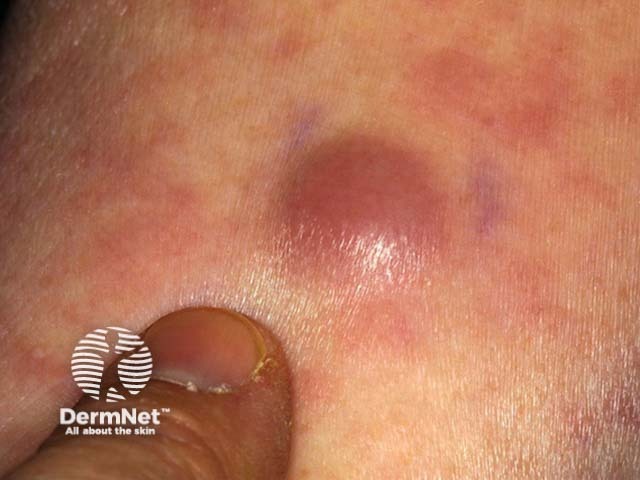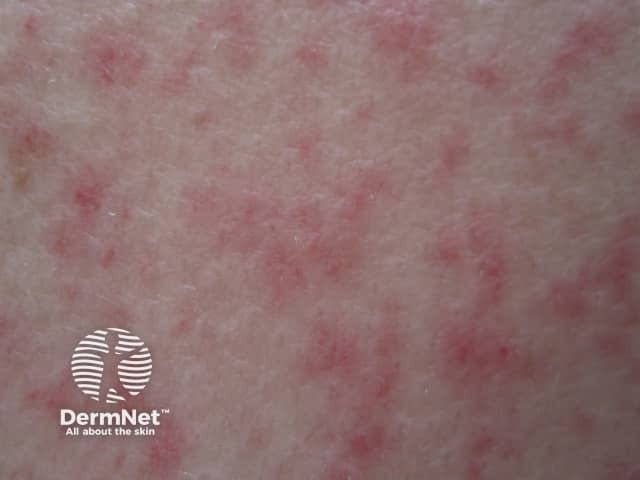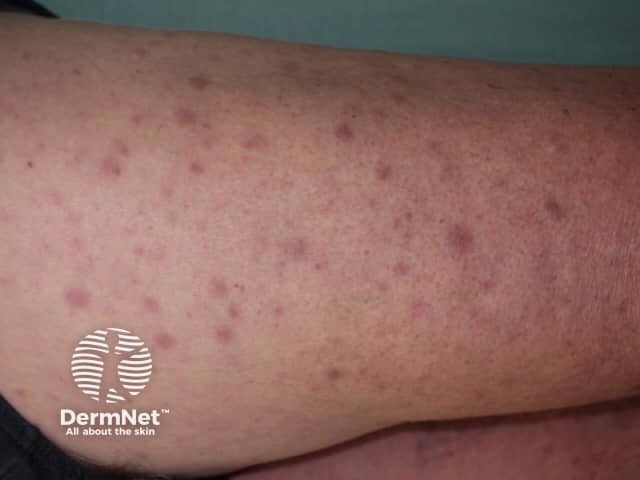Main menu
Common skin conditions

NEWS
Join DermNet PRO
Read more
Quick links
Lesions (cancerous) Systemic diseases
Author: Hon A/Prof Amanda Oakley, Dermatologist, Hamilton, New Zealand, 2010.
Introduction Demographics Clinical features Diagnosis Treatment Other associated skin disorders
Leukaemia cutis refers to the infiltration of the skin with leukaemia cells.
Leukaemia is the name given to a group of blood disorders in which there is a malignant proliferation of white cells (leukocytes). The leukaemia may be acute or chronic, due to proliferation of lymphocytes or more commonly, myeloid cells (the neutrophils). Clonal expansion or proliferation of identical abnormal cells mainly occurs in the bone marrow.
The most common types of leukaemia are:
Leukaemia cutis is rare, affecting about 3% of people diagnosed with leukaemia. It occurs in males and females of any age, and with almost any kind of leukaemia. In most cases, leukaemia occurs out of the blue. However, some kinds of leukaemia are associated with abnormalities of chromosomes, such as the Philadelphia chromosome.
Proliferation of the abnormal leukocytes is due to activation of oncogenes (cancer-promoting genes) or inactivation of tumour suppressor genes. Thus leukaemia is more common in syndromes that have mutations in these genes. These syndromes may be inherited and include Bloom syndrome.
Other known risks for the development of leukaemia include:
It is not known why the leukaemia cells sometimes choose to grow in the skin.
In most cases presenting with leukaemia cutis, the patient is already known to have leukaemia because of abnormal blood count or bone marrow findings.
The skin lesion is the very first sign of the haematological malignancy in 7% of patients with leukaemia cutis. This is sometimes called aleukaemic leukaemia. Bone marrow infiltration and systemic symptoms occur later.
Sometimes myeloid leukaemia relapses in the skin after apparently successful treatment of bone marrow. It is then called ‘extramedullary’ leukaemia.
Leukaemia cutis can present with various types of skin lesion. They are usually asymptomatic; that is, they are not itchy or sore.
‘Chloromas’ sometimes arise in myeloid leukaemia or granulocytic sarcoma. These may present as solitary or numerous nodules. They appear blue-green when cut into at the time of biopsy, hence the name. The colour is due to myeloperoxidase granules in the malignant leukocytes. This type of leukaemia cutis may precede the development of systemic leukaemia by several months.

Leukaemia cutis

Leukaemia cutis

Leukaemia cutis

Leukaemia cutis

Leukaemia cutis

Leukaemia cutis
Pancytopaenia occurs; that is, a reduction in red cells, white cells and platelets — all normally formed in the bone marrow.
Symptoms depend on which organs have been infiltrated by the leukaemic cells.
Leukaemia is suspected from an abnormal blood count and confirmed by sampling the bone marrow by aspiration or trephine.
Although leukaaemia cutis may be suspected from the patient's history and the appearance of the skin, skin biopsy is necessary to confirm the diagnosis. This reveals a diffuse infiltration of malignant leukocytes in the dermis.
Further histochemistry (immunostaining and immunotyping) may reveal the specific cell type involved. It is sometimes very difficult to diagnose leukaemia cutis.
Blood tests may include:
It is likely that imaging will be done to find out the extent of organ involvement and may include chest X-ray, abdominal ultrasound, CT scan, and MRI scan.
Treatment is directed towards the underlying leukaemia, so the patient should be under the care of an experienced clinical haematologist and/or medical oncologist. Systemic chemotherapy is the usual choice depending on the overall condition of the patient.
Other treatments include electron beam therapy, localised radiation, and phototherapy.
Fever usually indicates infection and requires investigation and treatment with systemic antibiotics, antifungal and antiviral treatment.
The prognosis is poor.
Patients with leukaemia are prone to a variety of skin conditions.